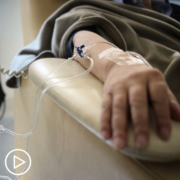What Is Low-Intensity AML Therapy?
What Is Low-Intensity AML Therapy? from Patient Empowerment Network on Vimeo.
How does low-intensity AML therapy differ from high-intensity AML therapy? Expert Dr. Ellen Ritchie provides a comparison of the administration methods, side effects and reviews which AML patients low-intensity and high-intensity therapy are right for.
Dr. Ellen K. Ritchie is assistant professor of medicine and a member of the Leukemia Program at the Weill Cornell Medical College of Cornell University and the New York Presbyterian Hospital. More about Dr. Ritchie, here.
Related Resources:

|

|

|
Transcript:
Katherine:
You mentioned earlier, Dr. Ritchie, low-intensity therapy. Could you tell us about the types of treatment options?
Dr. Ritchie:
So, I’ll go – high-intensity therapy or intense chemotherapy always has to be given really in a hospital. And if you don’t start it – if you can start certain intensive chemotherapies, like daunorubicin and cytarabine (Vyxeos), which is also intensive, in the outpatient setting, but by day seven or eight, you end up in the hospital. And in intensive chemotherapies, you lose your hair, there’s GI toxicities, you’re at high risk of developing infections and you need a lot of transfusion. And for even young people, it’s a difficult therapy for which you’re in the hospital, and 90-some percent of patients are on IV antibiotics.
So, it’s intensive chemotherapy because it has to be given in a hospital setting and requires intensive supportive care. Low-intensity therapy can be given in the outpatient setting. So, at the present time you can get a drug like azacitidine (Vidaza), for example, which is an injection that you get seven days in a row.
Unfortunately, you have to come to the doctor’s office every day for those injections, but once you’ve had the injection, you can go home. Combined with venetoclax (Venclexta) which is an oral agent. So, an oral agent can be given at home.
You need close supervision in the physician’s office when you’re on this type of therapy, but you don’t need the constant support that you need if you are getting intensive chemotherapy. So, it can be done, in the comfort really of your home and with your family. You will have to come in and have transfusions potentially as an outpatient, nearly everyone does. And there’s always the risk that you develop a fever and if you do, you have to come into the hospital for IV antibiotics.
But in general, low-intensity means not so much support needed in a hospitalized setting, and the tolerability of this particular chemotherapy in the outpatient setting.










